Can Acetone Clean Dried Acrylic Paint from Various Surfaces?
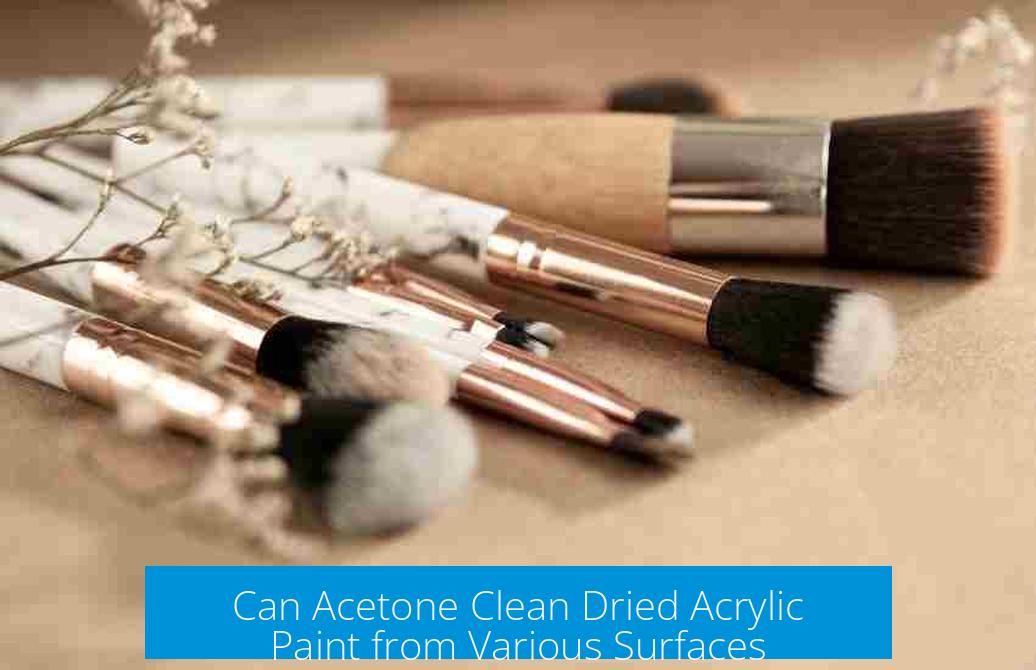
Acetone cannot effectively clean dried acrylic paint from most surfaces. It may only partially dissolve lower quality acrylics, but often fails to remove fully dried paint without damaging the surface underneath.
Effectiveness of Acetone on Dried Acrylic Paint
Dried acrylic paint forms a durable layer resistant to common solvents like acetone. While acetone can break down some weaker acrylic formulations, it generally does not dissolve hardened paint. This limitation reduces acetone’s usefulness for cleaning dried acrylic from most materials.
Risks of Using Acetone
Acetone is a strong solvent that can damage varnished, plastic, or painted surfaces. Its aggressive nature may lead to irreversible harm. Safer alternatives include alcohol-based solvents such as isopropyl alcohol or ethanol, which are gentler on many finishes but still limited in removing dried acrylics.
Recommended Alternatives and Best Practices
Mechanical Removal
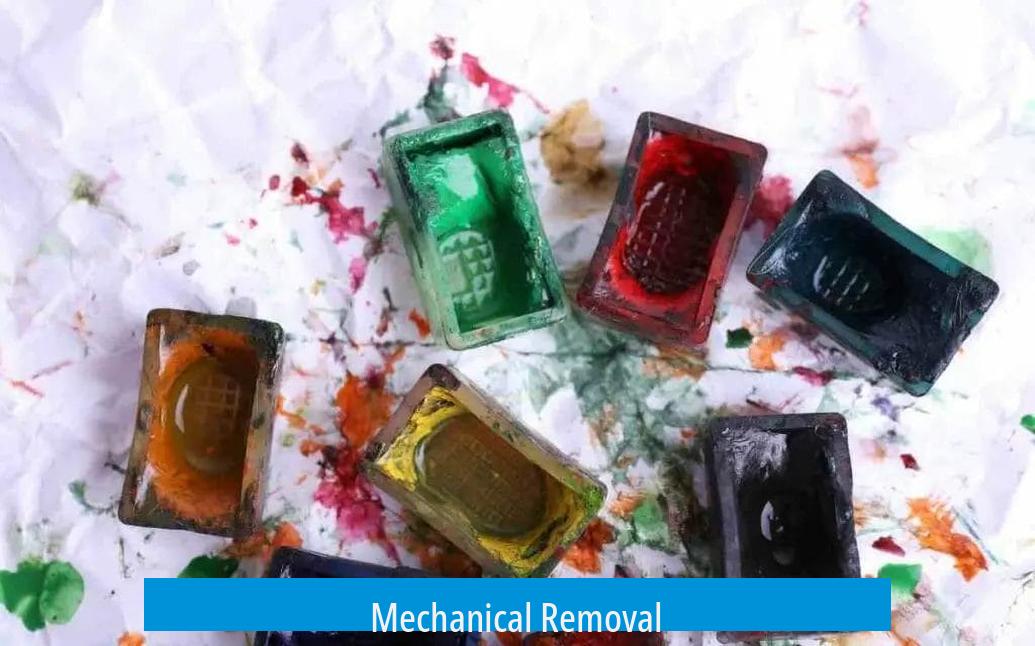
- Scraping dried acrylic paint is often the most effective option.
- Using a razor blade or scraper carefully can lift paint without harsh chemicals.
- Mechanical cleaning helps prevent surface damage compared to strong solvents.
Using Solvents Safely
- Always test solvents on a small, hidden area first.
- Solvents that attack acrylic paint well tend to harm the surface as well.
- Such strong chemicals should not be used in home settings due to safety and toxicity concerns.
Specialized Products
There are commercial products designed to remove dried paint, such as “Goofoff.” Availability varies by country. These options may be safer and more effective than acetone but still require caution.
Prevention Tips
- Clean up acrylic paint spills immediately with water before drying.
- Protect surfaces by covering with newspapers or plastic sheets during painting.
- Use drop cloths to catch drips and avoid unwanted paint on valuable items.
Key Takeaways
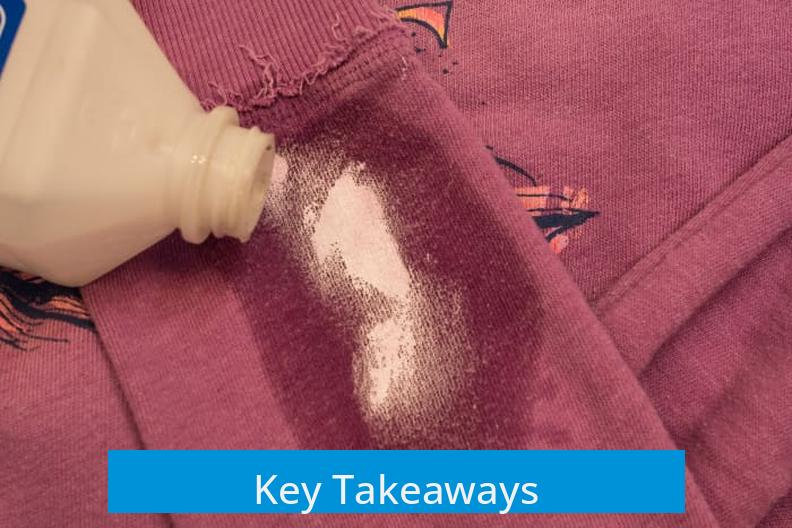
- Acetone generally does not remove dried acrylic paint and risks surface damage.
- Mechanical scraping is the safest and most reliable removal method.
- Alcohol-based solvents are milder but limited against dried acrylic paint.
- Test any solvent on a hidden area before use.
- Prevention by prompt cleaning and surface protection is critical.
Can Acetone Clean Dried Acrylic Paint from Various Surfaces?
Short answer? Acetone is mostly NOT your hero when it comes to cleaning dried acrylic paint, especially if your surfaces are varnished or delicate. Sure, rumors swirl about acetone’s magical powers, but reality has a few twists. Dried acrylic paint forms a tough polymer shell. Acetone, while a potent solvent, often just won’t break through that without collateral damage. Let’s unravel this painting mystery.
You’ve splashed acrylic paint, left it to dry, and now you’re staring at a stubborn patch on your wood table or glass window. Can grabbing that trusty bottle of acetone solve this mess? Well… not quite.
Why Dried Acrylic Paint Laughs at Acetone
Acrylic paint is essentially a plastic polymer emulsion. Once dried, it morphs into a hard, durable coating that does not play nice with mild solvents. Acetone can sometimes soften fresh or tacky acrylic paint because it disrupts the paint’s polymer chains. But for paint that’s fully cured and hardened? Acetone barely makes a dent.
Worse quality acrylic paints might be *partially* vulnerable to shredding by acetone or even ethanol, but that’s the exception, not the rule. Usually, you’re better off physically scraping or scrubbing the paint away. Yes, acrylics are a bit obnoxious like that.
Beware: Acetone Can Be a Double-Edged Sword
Ready for the plot twist? While acetone aggressively attacks some stubborn paints, it is also notorious for damaging surfaces. Wood finishes, varnishes, plastics, and synthetics can melt or discolor faster than you can say “oops.” So, before drenching your precious furniture in acetone, consider if the risk is worth it.
Many enthusiasts recommend safer alternatives like alcohol-based solutions — rubbing alcohol with isopropyl or ethanol base. These are gentler on surfaces while still offering some dissolving power on fresh paint.
Pro Tip: Mechanical Cleaning Reigns Supreme
For dried acrylic paint, there’s no substitute for elbow grease. Scraping it off with a razor blade or similar tool after the paint fully dries remains the most dependable method. Gentle but firm scraping helps remove paint without eroding the item underneath.
Think of it as the ultimate “paint exfoliation” technique. Just be patient and careful to avoid scratching.
Still Want to Use Solvents? Test First!
If solvents intrigue you, always test on a small, hidden patch before going full throttle. You want to make sure the underlying surface does not warp, discolor, or lose its finish. Ironically, the best solvents effective against acrylic paint are often hazardous, expensive, or inappropriate for home use.
Remember: “The solvent that melts dried acrylic paint without damage” is probably the unicorn of home cleaning products. Handle any chemical with respect, protective gloves, and proper ventilation.
Specialized Products for that Mean Acrylic Stain
Got a particularly nasty residue? Commercial products like “Goofoff” exist and specifically tackle dried paint. While not universally available, they shine in specialized cleanup scenarios. These are designed to break down tough paint without wrecking your belongings.
However, these products might require patience, repetition, and safety precautions. They are not miracle workers but rather chemical assistants for serious problems.
Prevention: The Best Cleanup Hack
Why cry over spilled paint if you never let it dry on your prized surfaces? The golden rule is to clean up acrylic spills promptly, always before drying. A simple water wipe can save you hours of hassle. Acrylic paint is water-based initially, so a damp cloth can wipe fresh spots away easily.
Always prepare your workspace with newspaper, plastic sheeting, or an old cloth before painting. This tiny upfront effort saves massive headaches later.
Summary Comparison Table: Cleaning Acrylic Paint
| Method | Effectiveness on Dried Acrylic | Surface Risk | Practical Notes |
|---|---|---|---|
| Acetone | Low to moderate (mainly fresh paint) | High (damages varnish, plastic) | Use cautiously, test first |
| Isopropyl/Ethanol Alcohol | Moderate (best on tacky paint) | Low to moderate | Gentler, safer for many surfaces |
| Mechanical Scraping | High | Depends on technique | Best for cured paint; avoid deep scratching |
| Specialized Products (e.g., Goofoff) | High | Variable | Good option if available |
| Vinegar (Acidic) | Variable, better on non-porous surfaces | Moderate (smell can be strong) | Use on glass, less effective on fabric |
Final Thoughts: Should You Reach For Acetone?
In conclusion, while acetone is a chemical powerhouse, it is not the reliable go-to for cleaning dried acrylic paint from all surfaces. It might work a tiny bit on some paints but risks ruining your furniture, plastic, or precious finishes. Instead, favor mechanical scraping—smart, safe, and often the most effective strategy.
If you insist on solvents, start with milder alcohol-based options and always perform small tests. For those stubborn paint stains, specialized commercial removers can offer assistance without total destruction.
And the best line of defense? Prevention. Clean any spills before drying, prep your workspace, and respect acrylic paint’s stubborn streak.
So next time your brush slips, don’t panic. Grab your scraper, stay calm, and leave the acetone for your nail polish removal. Your surfaces will thank you.
Can acetone remove dried acrylic paint effectively?
No, acetone does not effectively remove dried acrylic paint. It might only partially dissolve lower quality acrylics but generally fails to clean dried paint without damage.
Will using acetone damage the surface under the acrylic paint?
Yes, acetone can damage many surfaces. It’s safer to avoid acetone on varnished or sensitive materials.
What is the best method to remove dried acrylic paint?
Mechanical methods like scraping with a razor blade work best. Scrubbing or scraping is usually more effective than solvents.
Are there safer chemical alternatives to acetone for acrylic paint removal?
Alcohol-based solutions with isopropyl alcohol or ethanol are safer. Test any solvent on a small patch before full use.
Are there products designed specifically for removing dried acrylic paint?
Yes, specialized products like Goofoff can be used to remove dried paint, but availability varies by region.


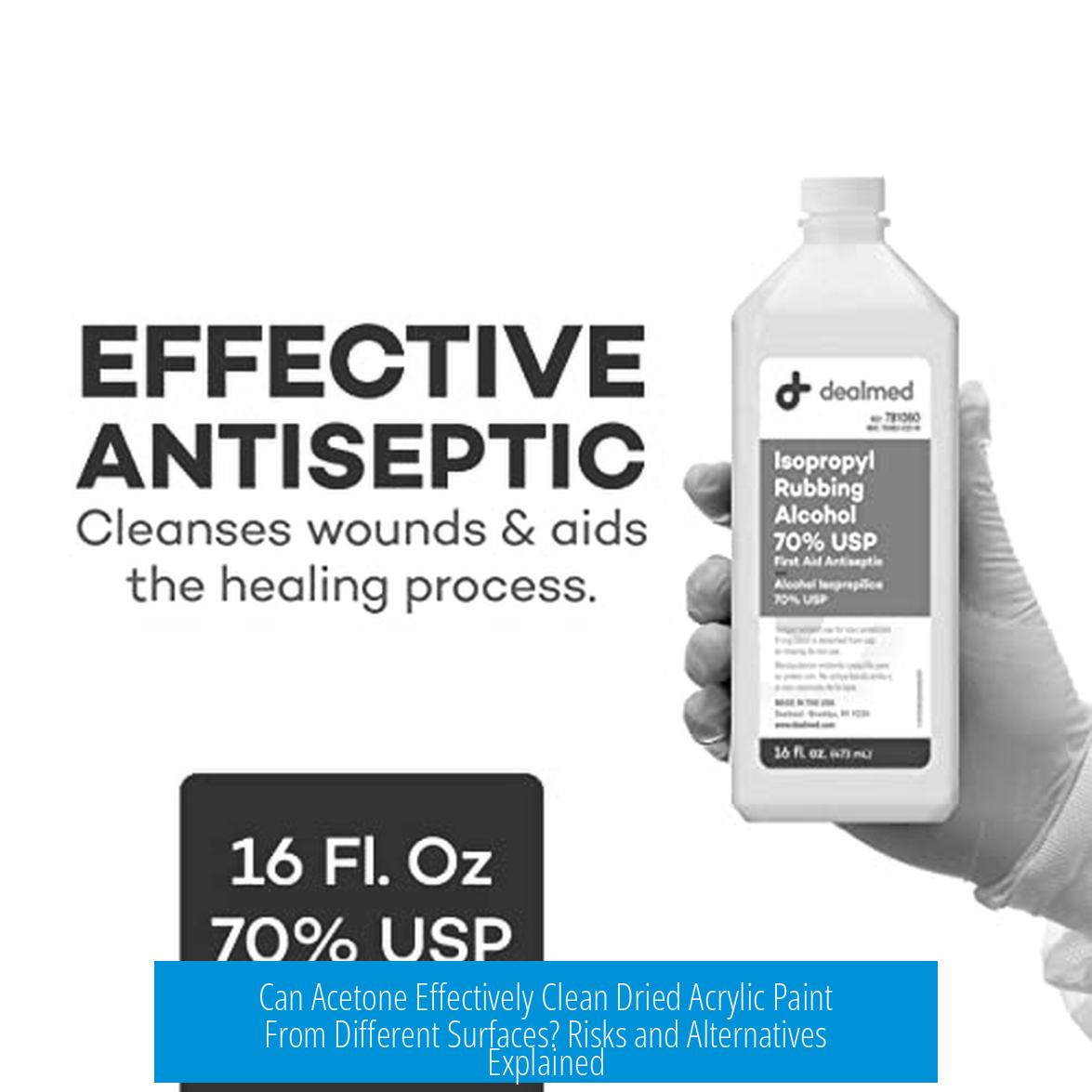
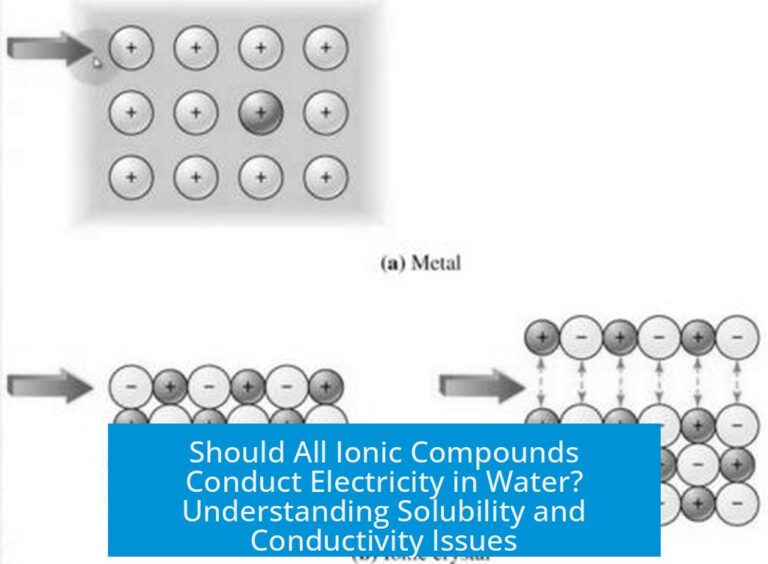
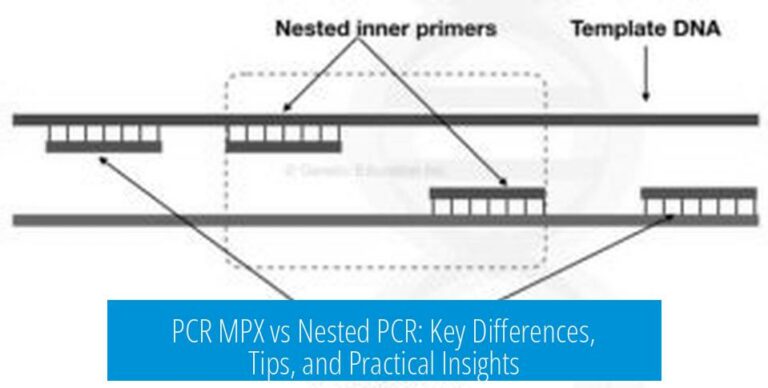
Leave a Comment